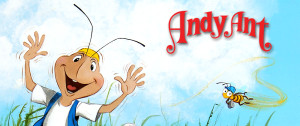
Story Writing Hints
By
Gerald D. O’Nan
Author of the
Adventures of Andy Ant Books
(Note: I will try to give you hints and ideas about writing stories using the 8 books in The Adventures of Andy Ant as examples. Having a set of the Andy Ant books available will help you understand the context better, but it isn’t necessary if you have a good imagination.)
The Reader’s “View” – Paint Pictures With Words
If you are truly writing with emotions and feelings you will try to paint pictures of the emotions. You can write about how your character feels, how you feel, or even how you would like to feel or how you don’t want to feel. Some of the most common emotions that our characters feel are fear, sadness, excitement, anticipation, anger, happiness, ready for action, and many types of pain.
The beginning of your “painting” is to make the reader feel what you (or your character) feel. Use your imagination to think about how you would feel in the same situation your character is experiencing. For example, remember a time when you were very sad or very happy. Pretend that is how you feel now. Let your character experience those same feelings. Since you are the author you can make those emotions more exciting/sad/happy.
Remembering those feelings and conveying them to the reader isn’t always easy, especially if the event you are remembering took place a long time ago. One of the benefits of keeping a journal is to help you remember the event AND the feelings that went along with the event.
Once you have a feeling that you are going to give to your character – and pass along to the reader – you are ready to start your “painting.” The objective is not to tell the reader but to show the reader how your character is feeling. Here is a very simple example: You could simply tell the reader, “It was a hot summer afternoon while Joey was pulling weeds.” Or, a possible, “painting” of how Joey was feeling might be, “The sweat was dripping down his forehead and he took his shirt off just trying to stay cool. His hands were sweating so much that the weeds slipped through his fingers.”
An example from the Adventures of Andy Ant, The Swimming Hole Disaster: “I turned and looked down the street and I froze in horror…” With his body being frozen in horror, we can “see” that Joey was scared! Shortly after this statement, Joey says, “My body froze, again, as I watched the water run into the drain. My legs felt like jelly and I thought I was going to be sick…” The reader starts to “see” an even better picture of Joey’s emotions.
Here are a few other brief examples of painting pictures with your words:
Rather than just saying your character is angry let the reader see the anger – “His fists were clinched, and he was gritting his teeth. His face was so red that he looked like he was going to explode.”
If your character is sad, you could paint the picture by saying, “A tear trickled down her cheek…”
If your character is disappointed, “Her chin was dragging on the ground…”
Make every effort to “show” emotion rather than only stating the emotion!
Copyright © 2023 by Gerald D. O’Nan All Rights Reserved. No part of this document may be used or reproduced by any means, graphic, electronic, or mechanical, including photocopying, recording, taping, or by any information storage retrieval system without the expressed written permission of the author except in the case of brief quotations embodied in critical articles and reviews.



